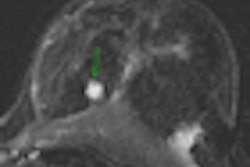In mammography, lower radiation dose isn't just better for the patient. It also produces the best images, according to research from the University College Dublin in the Republic of Ireland that was presented at the European Congress of Radiology (ECR) earlier this month in Vienna.
A large-scale study of Irish breast centers found mammography image quality correlated with mean glandular dose, with the best images having significantly lower dose than inadequate ones.
"The influence of the highest image quality on the attainment of the lowest radiation dose has been shown in this research, and thus greater consideration must be given to virtually all mammographic images to make sure that they achieve this perfect appellation," said Desiree O'Leary of the University College Dublin in the Republic of Ireland.
Currently, published levels of mean glandular dose delivered to the breast are expressed in terms of compression levels applied to the breast, or as mean doses for the population, which are sometimes qualified as being in the 75th or 95th percentile of the measured population, O'Leary said.
None of these published studies, however, describes image quality assessment or mentions if inadequate images are discarded prior to assessment of mean glandular dose for that population, she said. As a result, the study team sought to measure the effect of image quality on mean glandular dose, and vice versa, as part of a national mammography optimization study.
In their quantitative and qualitative study, the researchers gathered data from 16 mammography centers. Including both public and private facilities, the units encompassed the spectrum of mammography systems and included both film-screen images (which were digitized for the purposes of the study) and full-field digital mammography images.
Image quality, compression, and radiation dose data were collected from a minimum of 60 consecutive patients at each location. Image analysis was performed using two methods: quality assurance guidelines for radiographers from the U.K. (more popularly known as the PGMI image criteria) and the European guidelines on quality for diagnostic radiographic images (more popularly known as the CEC criteria), according to O'Leary.
The perfect image would meet all criteria within the guidelines, while good images will have minor errors in a minimum of the criteria, she said. Moderate image quality would still be acceptable for diagnostic purposes, while an inadequate image must be repeated.
The researchers also performed additional evaluation of factors that may affect image quality, including pectoral-nipple line analysis, surface skin rosette visibility, breast density classification for anatomical noise, and detail visualization. They also examined breast size and volume calculation for lesion conspicuity, and took into account confounding factors such as patient body mass index, effect of first-time attendees, and the effect of breast surgical alteration on image quality.
The final study incorporated 4,071 images from 1,010 patients at the 16 units. Mathematical modeling and statistical tests were then performed on the data. The researchers matched the highest image quality to the lowest achievable radiation doses and discarded the inadequate images from the dataset in order to provide final recommendations on mean glandular dose.
Of the 4,071 images, 6.2% were determined to be inadequate, a figure that's higher than recommended by the U.K. and European quality guidelines, she said.
ANOVA F ratios and radiation dose measurements demonstrated that images considered to be perfect had a much lower mean glandular dose than the inadequate images, for both digital and screen-film images as well as on both mammographic projections, O'Leary said.
Mean glandular dose required to produce a perfect image:
- Analog craniocaudal: 2.10 mGy
- Analog mediolateral oblique: 2.25 mGy
- Digital craniocaudal: 1.23 mGy
- Digital mediolateral oblique: 1.28 mGy
As a result, radiographers performing mammography at Irish breast centers should receive greater training to standardize mammographic projections to ensure that mean glandular doses are at their lowest levels, according to O'Leary.



















